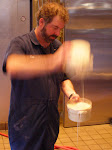 Craft Brewers have a bad habit of slamming the big "formerly" American breweries. I avoid doing that because I have good friends that work for the South Africans that own Coors, and those beers certainly have their place, like at a baseball game on a sweltering July afternoon. Still, the best place to be at Coors Field is not behind home plate but rather in "the cellar" of the stadium's Blue Moon Brewery drinking the incredible liquid creations that Tom and John have won so many medals for that if you melted them down you could build another brewery with them.
Craft Brewers have a bad habit of slamming the big "formerly" American breweries. I avoid doing that because I have good friends that work for the South Africans that own Coors, and those beers certainly have their place, like at a baseball game on a sweltering July afternoon. Still, the best place to be at Coors Field is not behind home plate but rather in "the cellar" of the stadium's Blue Moon Brewery drinking the incredible liquid creations that Tom and John have won so many medals for that if you melted them down you could build another brewery with them.I do however have a favorite big brewery slamming joke, the classic: "Drinking Coors is like making love in canoe....fucking close to water." Light beer is after all, a watered down version of their regular beers, which in turn are watered down versions of classic European lager styles that we make.
Fact of the matter is that all beer is mostly water and that brings me, finally, to the point of this post. Not only does drinking beer directly at the brewery guarantee you the highest quality beverage, as Augie Busch himself said in a Budweiser commercial, "The best beer is in the Bright Tank..." nothing good happens to beer after it leaves the love and care of the brewers (kind of like sending your daughter off to college.) But because water is so heavy, and even with recycling, packaging is so environmentally unfriendly, if you truly love the planet you should drink beer at it's source.
The math is pretty straight forward: it takes about 25 pounds of malt and hops to make one keg, or seven cases , of beer that weighs 160 pounds. A pallet of malt translates to ten pallets of kegs or 15 pallets of cases that will be shipped out all over the country requiring that many times the amount of fossil fuels. Moreover, kegs then need to be returned for cleaning and refilling. Bottles and cans are even worse as they require natural resources, on top of energy for shipping, to generate them and the labels, six packs, and cartons that contain them. Just like refilling a bottle of water makes more sense than spending a fortune and filling landfills, and our breweries use the water out of the pipes but with filtration better than Brita.
And its not just energy and natural resources you save by drinking better beer at the brewery, you might just save the health if not the life of your brewer. When I was a strong spry twenty-something cellar rat, I never thought twice about humping one of those 160 pound kegs up a flight of stairs, or stacking them three high on top of each other in tight coolers. But by the time I turned 40, as with most of my craft brewing colleagues, my back was shot and I eventually had to have my right ankle fused with 8 titanium screws and cadaverous bone marrow (which would be a great zombie movie device.)
If a craft brewer is responsible for 1,000 bbls of production in a year, that means he has moved approximately 50,000 pounds of malt, and 100,000+ pounds spend grain at the end of the brewing process. If the beer is simply going into a serving tank, other than humping hoses for cleaning and taking kegs to festivals the worst of the damage is done. But if the same sad sap is in a production plant, he is having to haul probably an extra 400,000 pounds of kegs and cases.
So drink at the brewery, and foil this Chiropractor's Conspiracy!


No comments:
Post a Comment